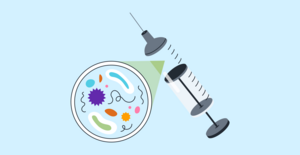Food Allergy Testing
Getting tested for food allergies is crucial for preventing unnecessary avoidance of food and reducing your risk of potentially life-threatening allergic reactions.
Who should get a food allergy test?
You should consider getting a food allergy test for you and your child if you develop symptoms of an allergic reaction typically within two hours after exposure or eating certain types of food.
You may also consider food allergy testing if you or your child have risk factors for food allergies. According to the American Academy of Allergy, Asthma, and Immunology, your risk for food allergies is increased with the following:
- An immediate family member has any allergic disease
- Severe eczema: Genetic mutations in the filaggrin gene have been associated with both food allergy and increased eczema severity
- Asthma
- Other food allergies
How to get a food allergy test
Food allergy tests are provided by healthcare providers at clinics and urgent care centers. However, the American Academy of Allergy, Asthma, and Immunology recommends getting tested by an allergist, a doctor with expertise and specialized training, if you have food allergy symptoms or another food-related condition. You can get a food allergy test by scheduling an appointment with an allergist who can identify the source of food allergy and order the appropriate food allergy test. Contact Solv to locate a food allergy testing center in a convenient location and to schedule an appointment at your earliest convenience.
What to expect during a food allergy test
During the food allergy test, you can expect the allergist to start by asking you questions about your symptoms to establish a history or allergic reaction to food. The allergist will ask questions about the food that you or your child eat, the characteristics of your symptoms, frequency, and how long it takes for you to develop symptoms after eating.
According to the National Library of Medicine (NLM), these are some of the questions you may need to answer before the test:
- Did you or your child eat eggs, peanuts, tree nuts, cow’s milk, shellfish, wheat, soy, or tinned fish two hours before your symptoms started?
- Did you or your child eat the food before?
- Did you or your child experience a reaction when you ate the food in the past?
- At what age or when did the allergic reactions to the food start?
- How was the food prepared? Did it have large or small amounts of the suspected food allergen?
- What symptoms did you or your child experience during the reaction?
The answers to these questions will help identify the type of food allergy and provide details about the type of allergic reaction involved. Once the allergist identifies the suspect food allergen, they can conduct a skin prick test, blood test, or both to confirm the diagnosis. If the results of these tests are inconclusive, the allergist may need to do an oral food challenge (OFC) test.
Skin prick test
The skin prick test evaluates the response of your skin to the presence of a food allergen. According to the NLM, the allergist will place a small amount of the food allergen into the skin on your forearm or back. Using a needle or plastic device, the allergist will slightly scratch or cut the skin surface allowing a very small amount of the allergen to enter the skin. You are unlikely to feel any pain, and there is no bleeding. If you or your child have been sensitized to the food, your body will react with an IgE response and produce a bump at the center of red itchy skin, known as a wheal. The size of the wheal indicates the likelihood of a food allergy. However, the size of the wheal does not accurately predict a food allergy. The absence of a wheal is an indication that you are most likely not allergic to the food.
Blood test
The food allergy blood test evaluates the levels of inflammatory compounds formed by your immune system after exposure to an allergen, known as IgE antibodies, in your blood. A healthcare professional will use a small needle to collect blood into a test tube from a vein in your arm. According to the American College of Allergy, Asthma, and Immunology, a blood draw lasts for a few minutes, and you may experience a small prick when the needle is inserted and removed from the vein.
Oral food challenge test
The OFC can be done in several ways. According to the NLM, the OFC can be done in an open challenge with both you and the allergist aware of the food you are eating, a single-blind challenge when you are unaware of the food, and a double-blinded placebo-controlled challenge with both you and the allergist unaware of the food you are eating. You and your child will be less likely to have a double-blinded placebo OFC challenge time because it takes a long time and is less commonly done.
Risks of food allergy testing
The NLM notes that there is some inherent risk associated with food allergy testing. During the OFC and skin prick test, an allergen will be introduced into your body. There is a risk of having a severe reaction to the test. You may also develop minor skin irritation, pain, or a minor bleed from the skin test or blood draw. The sight of blood may cause you or your child to faint.
Find Food Allergy Testing near you
- Alabama
- Alaska
- Arizona
- Arkansas
- California
- Colorado
- Connecticut
- Delaware
- Florida
- Georgia
- Hawaii
- Idaho
- Illinois
- Indiana
- Iowa
- Kansas
- Kentucky
- Louisiana
- Maine
- Maryland
- Massachusetts
- Michigan
- Minnesota
- Mississippi
- Missouri
- Montana
- Nebraska
- Nevada
- New Hampshire
- New Jersey
- New Mexico
- New York
- North Carolina
- North Dakota
- Ohio
- Oklahoma
- Oregon
- Pennsylvania
- Rhode Island
- South Carolina
- South Dakota
- Tennessee
- Texas
- Utah
- Vermont
- Virginia
- Washington
- Washington DC
- West Virginia
- Wisconsin
- Wyoming
Food Allergy Testing FAQs
Is there a single test for all food allergies?
There is no single test for all food allergies. A significant number of food allergens have been identified for some tests. New tests such as the allergen component-resolving diagnostic testing (CRD) can be used for more than 100 purified allergens in one test, but they can miss some food allergens.
What is the most accurate type of food allergy test?
According to the NLM, the most accurate food allergy test is the double-blinded placebo oral food challenge test. Medical supervision is critical for the OFC because your food allergy may be life-threatening. The OFC is typically conducted when the results from the skin test or blood test are inconclusive.
Can medications affect the skin test?
Antihistamines can interfere with skin tests and give you inaccurate results, notes the NLM. Some allergic food reactions occur when food allergens bind to certain cells, such as mast cells and basophils, causing a release of histamines. Your antihistamines can prevent the release of histamines and affect the accuracy of the test.
What should I do if I am taking medications?
Tell your allergist about all your prescribed and over-the-counter medications and supplements. The allergist will let you know if your medications will affect the test. If you need to stay on your medications during the food allergy test, your allergist may perform a blood test instead of a skin test.
How long does it take to get the results of the food allergy test?
You can get the results of the skin test at the clinic visit. The skin test results are usually available within 15 to 30 minutes. You do not get the results of the blood test at the clinic. You can typically expect the blood test results in about one to two weeks.
What symptoms suggest that my child or I need a food allergy test?
The NLM reports the following as symptoms for a food allergy test:
- Skin symptoms; flushing, itching, and swelling
- Upper respiratory reactions; sneezing, runny nose, and congestion
- Breathing symptoms; difficulty breathing, wheezing, and coughing
- Digestive symptoms; nausea, vomiting, abdominal pain, and diarrhea
- Circulatory symptoms; light-headedness, fainting, and low blood pressure
Why do I need to get tested if I have symptoms?
The NLM recommends that ouu get tested if you have food allergy symptoms to determine if it is a true allergic reaction or food intolerance. Testing will help improve your quality of life as your allergist identifies the food allergen, and you will no longer maintain a needless restrictive diet.
What is the next step if my food allergy test comes back positive?
If your test comes back positive, the allergist may ask you to avoid the food allergen. Your allergist may prescribe antihistamines for mild reactions as well as an epinephrine auto-injector if you have had an anaphylactic reaction before or are at risk for anaphylaxis.
Can the food allergy go away after I test positive?
Allergies to common foods like eggs and milk are likely to go away, according to the American College of Asthma, Allergies, and Immunology. Your allergist will continue to evaluate you and your child to determine if the food allergy is resolved. The American College of Asthma, Allergies, and Immunology recommends yearly skin tests or IgE tests to evaluate resolution.
How can I find a place to test for food allergies near me?
Solv has strict sourcing guidelines and relies on peer-reviewed studies, academic research institutions, and medical associations. We avoid using tertiary references.
Everyday Healthcare, Simplified
Expert advice to help you live your best life

 LinkedIn
LinkedIn


